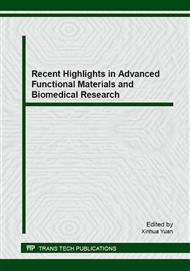p.23
p.29
p.33
p.37
p.41
p.45
p.49
p.55
p.61
Simultaneous Determination of Pb2+ and Co2+ Based on Fluorescence Quenching of Bi-Color Quantum Dots with the Aid of Multivariate Calibration Techniques
Abstract:
Simultaneous determination of Pb2+ and Co2+ without separation has been successfully achieved by a bicolor quantumn dots mixture. This method takes advantage of the different degrees of the fluorescence quenching effects of Pb2+ and Co2+ to the bio-color quantum dots. Chemometrical approaches were applied to assist the discrimination and detection process. The construction of the multivariate calibration models, based on partial least squares (PLS), orthogonal projections to latent structures least squares (O-PLS) and kenel based orthogonal projections to latent structures (K-OPLS), allowed the simultaneous determination of Pb2+ (in the concentration range of 0-120 mM) and Co2+ (0-300 mM). The optimal number of factors in PLS and the optimal number of orthogonal components in O-PLS and K-OPLS were carefully selected. A comparison of prediction performances between these results was performed by relative prediction errors, square of the correlation coefficient and root mean squares error of prediction.
Info:
Periodical:
Pages:
41-44
Citation:
Online since:
December 2014
Authors:
Keywords:
Price:
Сopyright:
© 2015 Trans Tech Publications Ltd. All Rights Reserved
Share:
Citation:


